Ever thought about your elegant Russian Blue Cat, with its shiny fur and bright green eyes? It may seem calm, but these cats can act bossy at times. To understand and gentle their possible wild actions takes skill. Are you keen to learn how to quiet your cat and make it happy? Keep reading.
Known for their beautiful silver coats, Russian Blues are truly remarkable. They have a sleek body, a sharp face, and big ears. Even though they seem calm, they can show signs of being a bit wild.
Key Takeaways
- Understanding Russian Blue Cat behavior is crucial for managing aggression.
- These felines have a luxurious, dense double coat with silver tipping.
- Russian Blues may display assertive behavior despite their serene appearance.
- Adjusting your approach can help in taming your Russian Blue Cat’s wild side.
- Discover techniques to keep your Russian Blue calm and content.
Understanding the Russian Blue Cat’s Personality
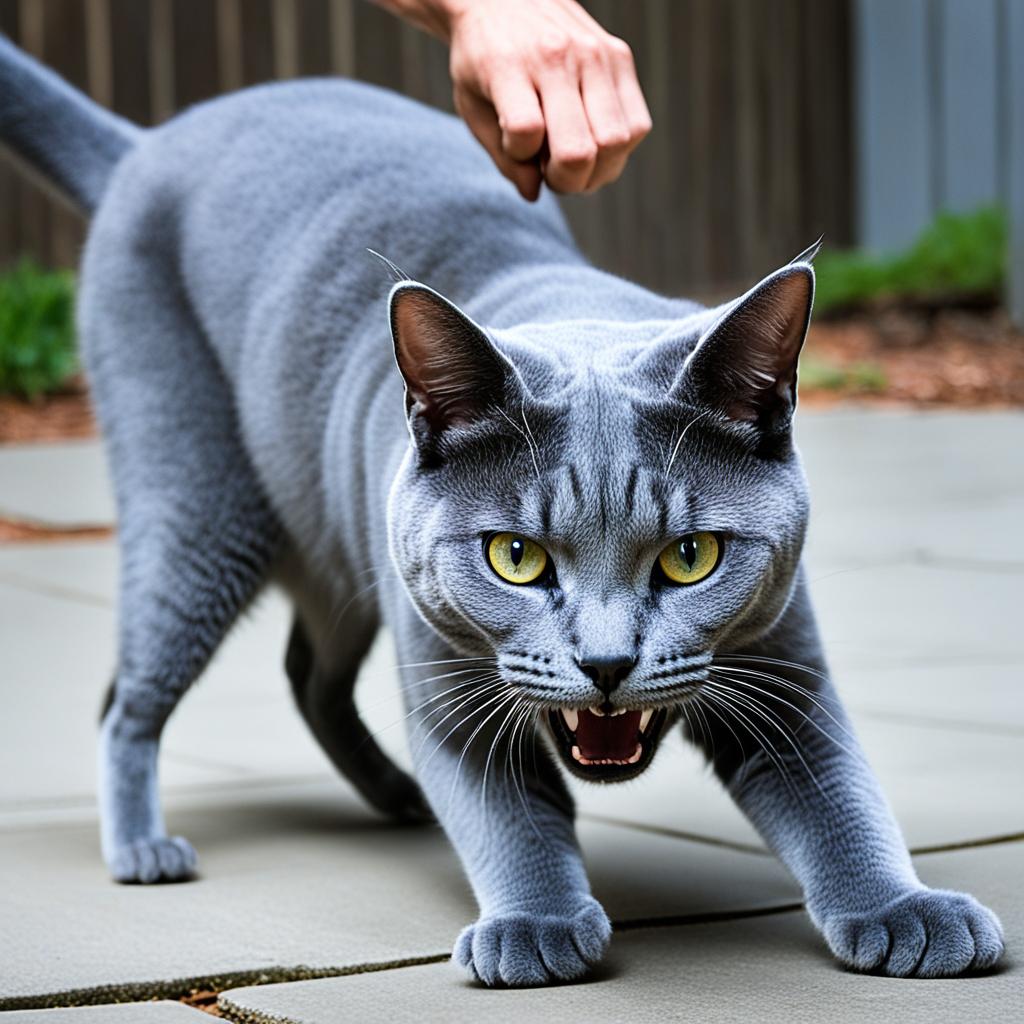
The Russian Blue Cat’s personality is intriguing. They combine smarts with a love for routine, building strong connections with people. Knowing what they like and why helps manage any aggressive behavior easily.
Intelligent and Thoughtful Nature
Russian Blue Cats are very clever. They remember where you put their toys and treats. If they hide something from you, they might even help you find it.
“It’s truly impressive how fast Russian Blues can pick up on new tricks and routines. Their sharpness makes them quick learners, turning playtime into a delightful dance.” – A delighted cat owner
Their brainpower also shows in how they play. These cats love learning new things and enjoy intelligently designed games. When they get a little too intense, linking it with their smarts helps us understand.
Affectionate Once Familiar
At first, Russian Blues may seem aloof. But, they warm up over time, becoming very attached to their people and space. They like predictable surroundings. Their growing comfort leads to more cuddles and affection.
Knowing how they become loving makes their possible aggression easier to manage. Building a strong, positive relationship is key.
Recognizing Aggressive Behavior in Russian Blue Cats

Even though Russian Blue Cats are usually calm, they can get aggressive in some situations. This part will show you how to spot the signs of aggression and find out why it’s happening.
Common Signs of Aggression
Aggression in Russian Blue Cats can show up in many ways. Look out for the following signs:
- Hissing and growling
- Defensive body posture—flattened ears, arched back, puffed tail
- Swatting, biting, or trying to hit
It’s key to notice these signs early. Then, you can find ways to deal with your Russian Blue Cat’s aggression.
Potential Triggers for Aggression
Knowing what sets off aggressive behavior in Russian Blue Cats is very important. Things that can cause it include:
- Territorial disputes: Introducing new pets or changes in the environment
- Fear: Loud noises or unfamiliar people
- Health issues: Pain or discomfort from an underlying medical condition
Dealing with these triggers is a major part of handling aggression in Russian Blue Cats.
How to Handle Russian Blue Cat’s Aggression?

Got a feisty feline? No worries! Here’s a witty guide on
Patience is crucial. Your cat might act aggressively due to fear, feeling like it needs to protect its space, or health issues. Remember, punishing your furry friend does more harm than good. It makes them stress out more and can increase aggressive behavior. Try to figure out what’s causing the aggression and work on that.
Consistency is key in dealing with your cat’s aggression. Keep a regular routine to make their environment stable. This helps a lot in managing a aggressive Russian Blue Cat. When you add new things, do it slowly and carefully. This keeps stress levels down and lessens the chance of them acting out.
Here’s a quick checklist to help you deal with aggression:
- Watch for any changes in how your cat behaves
- Stick to your routines
- Avoid punishments
- Use rewards to reinforce good behavior
- Make sure they have places they feel safe to go when they need a break
Looking at what might trigger their aggression can also help:
| Trigger | Potential Solution |
|---|---|
| Being scared of new places or people | Introduce them slowly to new things |
| Not wanting to share space | Give them their own areas and resources |
| Feeling unwell | Take them to the vet for a check-up |
By mastering these techniques, you can gracefully manage your Russian Blue’s aggression. This leads to a calmer, happier home for both of you.
Creating a Calm Environment for Your Russian Blue
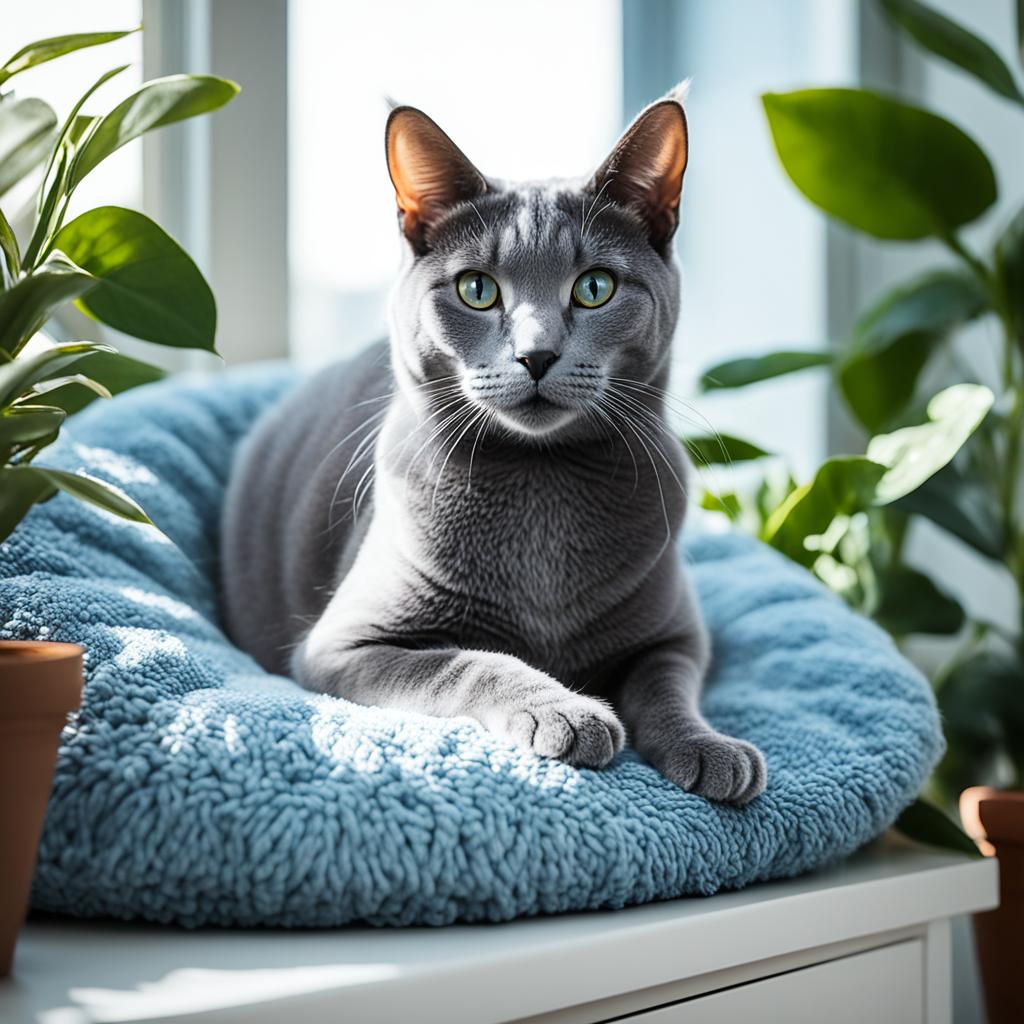
Making a calm atmosphere is key to reduce your Russian Blue Cat’s aggression. They love security and routine. So, create a space where they feel secure and relaxed.
Importance of a Safe Space
It’s vital to set up a special, quiet space for your Russian Blue. This area should be free from loud sounds and a lot of movement. Include cat trees, cozy beds, and places where your scent is strong. These things will make your cat feel safe and chill.
Using Calming Products and Toys
Using pheromone diffusers or sprays can calm your cat. Also, playtime with toys helps a lot. Choose toys that encourage hunting. They keep your cat’s mind and body active.
A mix of a safe spot, calming stuff, and fun toys is great for calming your Russian Blue Cat. By making your home fit their needs, you’ll build a peaceful place for your pet. This approach can make a big difference.
Training Techniques to Manage Aggression in Russian Blue Cats
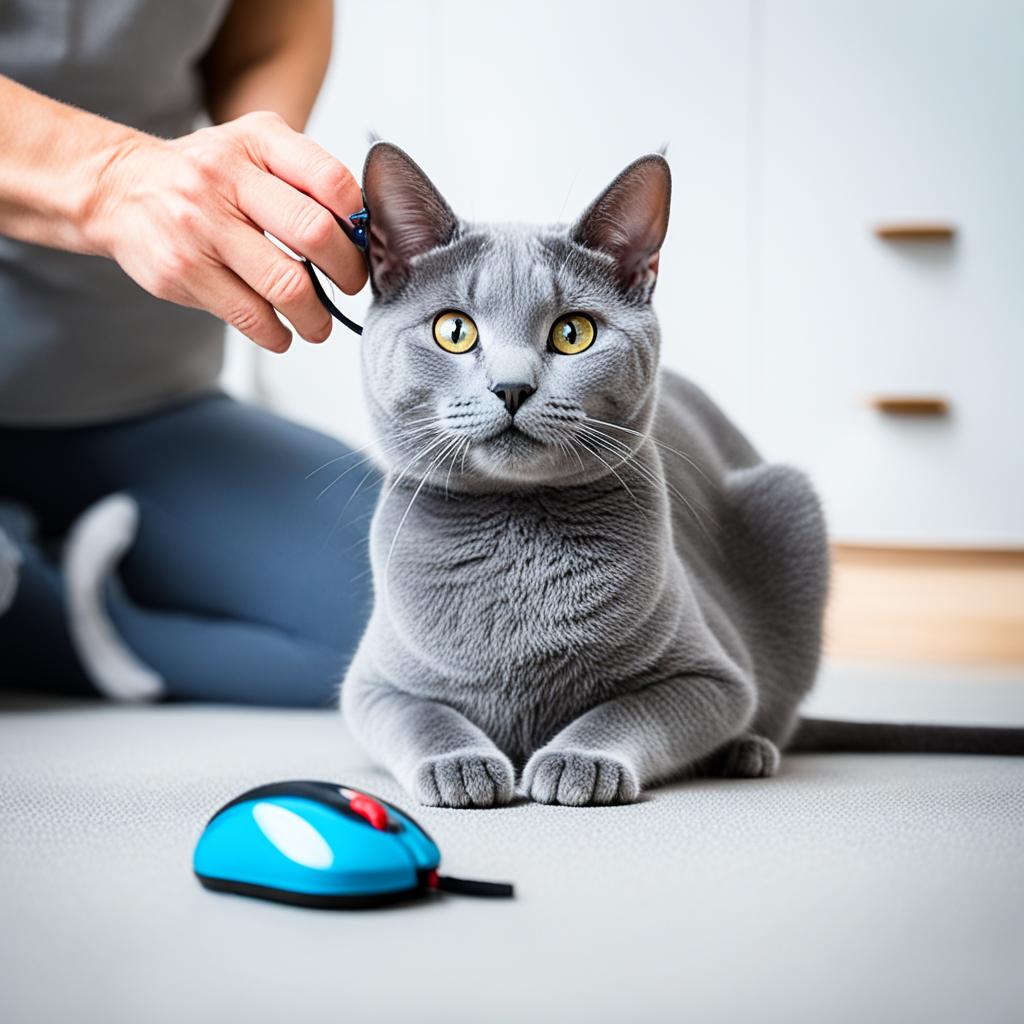
Finding effective training methods for aggressive Russian Blue Cats can turn things around. We’ll explore how to use positive reinforcement and maintain consistency. These approaches help with good behavior and make it last. It’s all about rewarding the right actions and sticking to the plan.
Positive Reinforcement Training
Using positive reinforcement can be a total game-changer. Rewarding your cat when they’re calm and friendly with you works wonders. This can be treats, kind words, or extra playtime. It shows your cat that being good means good things happen. It’s like a game with awesome prizes for doing well.
Consistency in Training Practices
You’ve got to be consistent in your training. Skipping days or changing the rules can mess things up. Make sure everyone at home knows how to train your cat the same way. Doing things the same every day helps the lessons stick. This way, your cat will start feeling safer and more loved.
Ensuring Proper Socialization with Other Pets

Properly introducing your Russian Blue Cat to other pets is key to a peaceful home. It might take time and a lot of patience. You need to watch how they act around other pets. This helps prevent any fights.
Here’s a way to make sure your pets get along:
- Controlled Introductions: Start with brief, supervised meet-ups. A leash or carrier can be helpful and keeps everyone safe.
- Separate Resources: Give each pet their own food, litter, and space. This reduces fighting over resources.
- Positive Reinforcement: Encourage good behavior with rewards. Both cats and other pets get treats, praise, or a light pet.
- Patience: Slow and steady is the best approach. Don’t hurry. An easy pace helps avoid misunderstandings.
Watching your cat’s behavior closely is crucial. Look for signs they might be getting upset, like a flicking tail. This lets you step in early to prevent a fight. The ultimate aim is everyone living peacefully together. Making sure your pets socialize well will make life easier for all.
Grooming and Maintenance Tips for a Content Cat

Your Russian Blue Cat needs some special attention to its gorgeous coat. Regular grooming helps keep their looks sharp and strengthens your bond. It’s a win-win for both of you!
Regular Grooming Routines
Consistent grooming is key to a happy Russian Blue. Brush their fur often. It prevents tangles, keeps them from shedding, and makes their coat shiny. Plus, this is a good time to check for skin problems.
Remember, grooming includes more than just brushing. Trim their nails, clean their ears, and wipe their eyes too. This keeps them from getting uncomfortable or sick.
- Brush their fur at least once a week.
- Trim nails every two weeks.
- Clean ears monthly.
- Wipe eyes regularly to clear discharge.
Handling Grooming-Related Aggression
Sometimes, grooming is not fun for cats. They might get aggressive if it scares or bothers them. Keep grooming times relaxed and use treats and praise. This helps make grooming a positive experience.
If your cat gets too upset, it’s okay to stop and try later. They might feel more calm then.
| Task | Frequency | Tools Needed |
|---|---|---|
| Brushing Fur | Weekly | Soft cat brush |
| Trimming Nails | Bi-Weekly | Cat nail clipper |
| Cleaning Ears | Monthly | Ear cleaning solution |
| Eye Cleaning | Regularly | Soft, damp cloth |
Providing Adequate Mental Stimulation
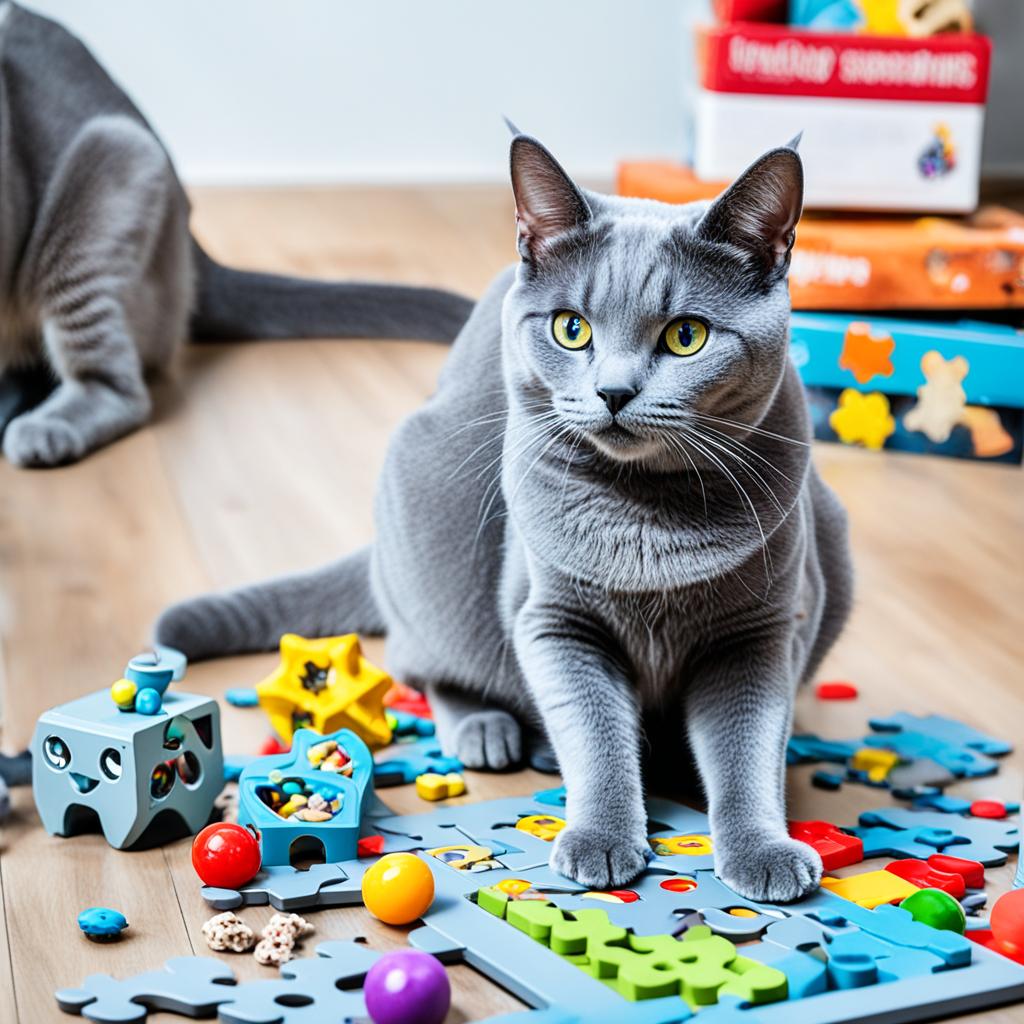
It’s key to keep your Russian Blue Cat’s mind active. This helps them stay calm and friendly. Give them toys and games that make them think. It’s also good for their health.
Toys and Games to Engage Your Cat
Choose interactive toys for your Russian Blue Cat. They’re great for mental stimulation. Here are some top picks:
- Feather wands
- Laser pointers
- Catnip-stuffed mice
- Interactive puzzle feeders
These fun items keep cats busy. They also tap into their natural hunting and problem-solving skills.
Interactive Playtime Ideas
Different playtimes keep your cat’s mind sharp. Try these to mix things up:
- Fetch the Toy: Throw a small, soft toy for your cat. This is both physical and mental fun.
- Treasure Hunt: Hide treats for your cat to find. It tests their smartness and nose.
- Agility Training: Set up play tunnels, jumps, and platforms. Your cat will love it!.
These games are not just for fun. They help manage your cat’s energy and mood, making them happier.
Diet and Health Considerations for Reducing Aggression
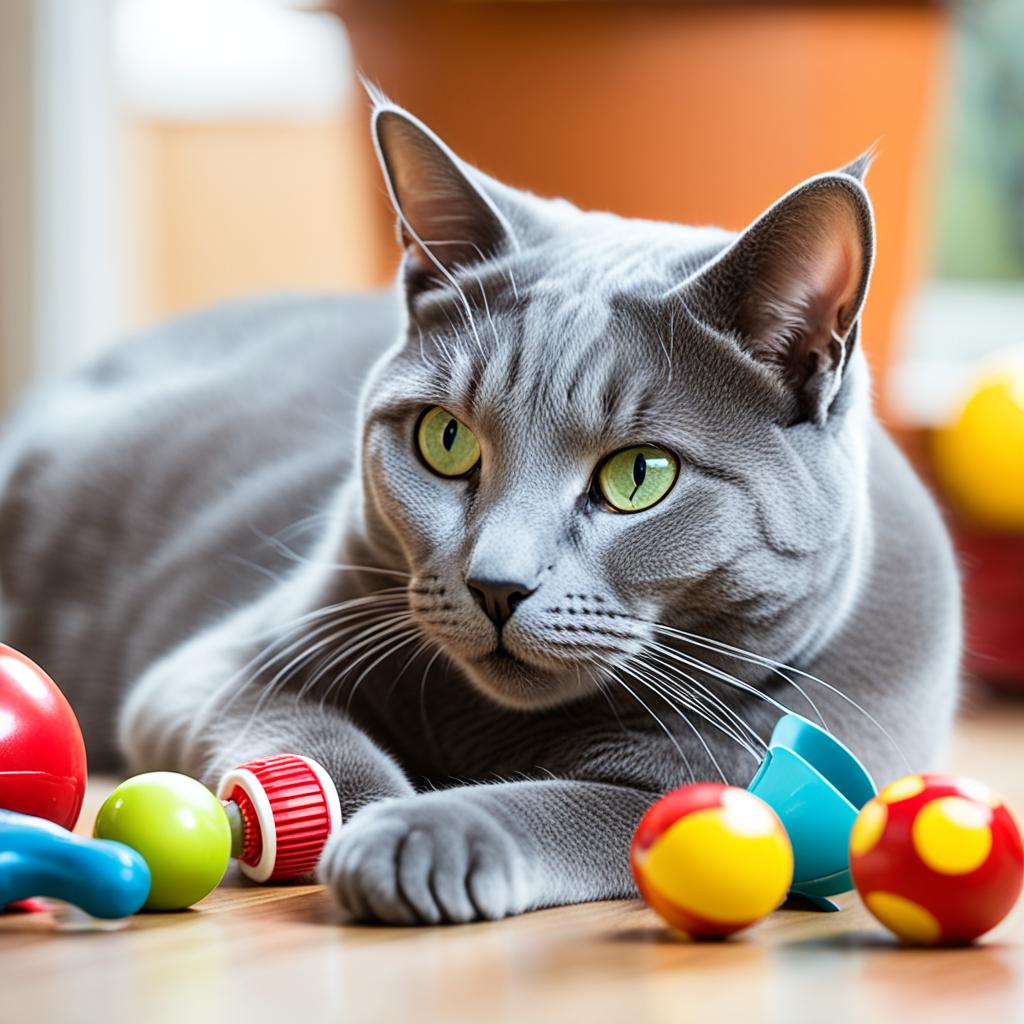
Your Russian Blue Cat’s diet is key in tackling their aggressive behavior. The right food and weight are vital for keeping them calm. This ensures your cat is happy and peaceful.
Choosing the Right Food
It’s important to choose food that fits your Russian Blue Cat’s needs. Foods high in protein and full of nutrients are best. Hill’s Science Diet and Royal Canin are good options for them.
Maintaining a Healthy Weight
Keeping your cat at a healthy weight is crucial for less aggression. Obesity leads to irritability and less playfulness. Watch portion sizes and keep meal times regular. Also, make sure to have your cat checked by a vet often.
| Key Element | Consideration |
|---|---|
| Protein Quality | High-quality proteins maintain muscle and energy levels, reducing aggression. |
| Meal Schedule | Eating at the same times daily reduces anxiety and aggression. |
| Weight Management | Portion control and a healthy weight prevent irritability and aggression. |
Conclusion
We’ve explored the world of the Russian Blue Cat and learned about handling its aggression. The key is noticing behavior and finding the causes. It’s important to create a peaceful home for our cats.
It’s crucial to make a calm environment to reduce aggression caused by stress. This includes safe places and soothing items. Training with rewards helps your cat behave well and not be afraid. Getting your cat used to others helps them live peacefully with friends.
Keeping your cat groomed and mentally active keeps them happy and healthy. Grooming stops aggression tied to discomfort. Toys and playtime help your cat act better by meeting its needs. A good diet is also essential. It keeps your cat content and less likely to act out. With these tips, you can curb your Russian Blue Cat’s wild side and enjoy a great bond.




